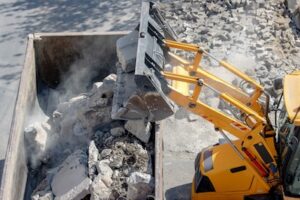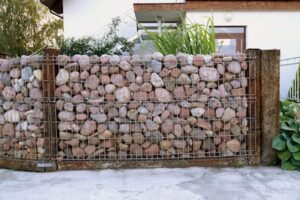Tips for How to Dispose of Concrete
Disposing of excess materials is one of the most important steps in any construction project. No project is complete until the last shred of extra supplies is properly and safely disposed of. However, this is easier said than done, as one of the world’s most popular building materials, concrete, is a major source of waste in the world. This is because concrete is a notoriously challenging material to properly dispose of. So, how do you dispose of concrete? Here are some different ways how to dispose of concrete:
- Use Recycled Concrete as Aggregate In New Concrete Projects
- Use Crushed Concrete as Road Base or Fill Material
- Use Crushed Concrete as Structural Fill
- Agricultural Amendments or Soil Stabilization Agents
- Gabions, Erosion Control Structures, Retaining Walls, etc.
- Take It to a Landfill or Recycling Center
- Repurpose Concrete for Home Use
In this article, we’ll talk about the importance of properly disposing of concrete and the different ways to properly dispose of concrete, so keep reading to find this out and more!

The Importance of Disposing Concrete Properly
Disposing of concrete properly is important in a construction project for several reasons.
First, concrete can be a trip hazard if not disposed of properly.
Second, concrete can be an environmental hazard if not disposed of properly.
Third, improper disposal of concrete can lead to fines and other penalties from regulatory agencies.
Finally, improper disposal of concrete can negatively impact the schedule and budget for a construction project.
The Different Ways to Dispose of Concrete
Concrete is one of the world’s most popular building materials, but it can also be a major source of waste. According to the U.S. Environmental Protection Agency, the construction industry alone generates more than 500 million tons of waste each year. But what if there was a way to put all that waste concrete to good use? Turns out, there is and that is what we will be discussing below.
1. Use Recycled Concrete as Aggregate In New Concrete Projects
When it comes to recycling concrete, there are a number of ways that it can be reused in new projects. One common way is to use it as aggregate in new concrete mixes. This can be an effective way to reduce the amount of waste concrete that is produced, and it can also provide a valuable resource for new construction projects.
2. Use Crushed Concrete as Road Base or Fill Material
Concrete is a versatile material that can be used for a variety of purposes. One common use for concrete is as a road base or fill material. Crushed concrete can be used as road base or fill material because it is sturdy and will not break down over time. Additionally, crushed concrete can be used to fill in any voids in the ground that need to be filled in order to create a level surface.
3. Use Crushed Concrete as Structural Fill
Concrete is a very durable material, which makes it ideal for use as structural fill. Crushing concrete allows it to be reused as aggregate in new concrete or other construction projects. It also reduces the need for landfill space and trucking costs associated with disposing of concrete waste.
4. Agricultural Amendments or Soil Stabilization Agents
Concrete can be pulverized and used as an agricultural amendment or soil stabilization agent. This material is commonly used in construction and landscaping projects. It can be a useful tool for farmers and gardeners who are looking to improve the quality of their soil. Pulverized concrete can help to improve drainage, aeration, and fertility in the soil. It can also increase the amount of organic matter in the soil, which can improve plant growth.
5. Gabions, Erosion Control Structures, Retaining Walls, and More
Waste concrete can be used to build gabions, erosion control structures, retaining walls, and more. Gabions are one of the most popular uses for waste concrete. Gabions are wire cages filled with rocks or other materials that are used to stabilize slopes, prevent erosion, and control flooding. They can also be used to build retaining walls and other structures.
There are many reasons why recycling construction materials is helpful and why you might choose one of these first five methods. Recycling construction materials is helpful for many reasons. It helps to conserve resources, save energy, and reduce pollution and waste. recycling construction materials also reduces the need for virgin materials, which can often be more expensive and require more energy to produce. In addition, recycling construction materials can create jobs in the recycling industry. Finally, recycling construction materials can help to support local economies by keeping money within the community.
If, however, none of these recycling methods are feasible for your project, you can consider disposing of your concrete in a more traditional way.

6. Take It to a Landfill or Recycling Center
You can either take it to a landfill or recycling center or find a company that will pick it up for you. If you have a small amount of concrete, you can likely just put it in your regular trash bin. However, if you have a larger amount, you will need to call your local waste removal company to find out the best way to dispose of it. They may have special requirements or charges for disposing of the concrete.
7. Repurpose Concrete for Home Use
Finally, consider all of the creative ways that concrete can be repurposed in the home. Concrete is one of the most versatile materials available for construction and home improvement projects. While it is most commonly used for driveways, patios, and foundations, there are a number of other ways you can use concrete to add value to your home.
Here are some creative ideas for how concrete can be repurposed in the home:
1. Create a Custom Concrete Countertop
Bear and Bison Concrete can be used for countertops, as concrete can be used to create beautiful countertops for your kitchen or bathroom. Concrete countertops are becoming increasingly popular in kitchens and bathrooms. They offer a unique look that can be customized to match any décor, and they are extremely durable. Concrete is also very easy to keep clean, making it an ideal material for food preparation areas.
If you’re considering concrete for your kitchen counter, there are a few things you should keep in mind. First, concrete is a porous material, so it can absorb stains and spills. Be sure to seal your countertop regularly to prevent this from happening.
Concrete is also a very heavy material, so be sure your cabinets are sturdy enough to support it. You may need to reinforce your cabinets or install additional supports if you choose concrete for your countertop.
Finally, keep in mind that concrete can be damaged by heat and scratches. Be careful not to place hot pans directly on the surface, and use cutting boards and trivets to protect it from scratches. With proper care, your concrete countertop will last for many years.

2. Make a Concrete Fireplace Surround
If you have a wood-burning fireplace, consider using concrete to create a custom surround.
3. Use Concrete to Make a Floor
Concrete floors are becoming increasingly popular in homes and businesses. This is because they are durable and easy to maintain.
4. Build a Concrete Walkway or Path
Add interest to your landscaping by creating a concrete walkway or path.
5. Use Concrete to Make a Retaining Wall
A concrete retaining wall can be a great way to add structure to your landscaping and prevent soil erosion.
6. Construct a Concrete Patio or Deck
Expand your living space by adding a concrete patio or deck.
7. Build a Concrete Pool
A concrete pool is a great way to add value to your home and enjoy the outdoors.
These are just a few of the many ways you can use concrete to improve your home. Be creative and see what you can come up with!
Conclusion
As you can see, disposing of concrete doesn’t have to be cumbersome, complex, or boring. By using a little innovation and creativity, you can recycle the concrete from your project to help protect the environment, improve your home, and create jobs.
